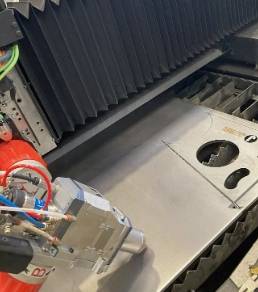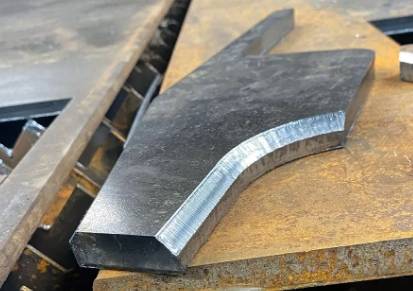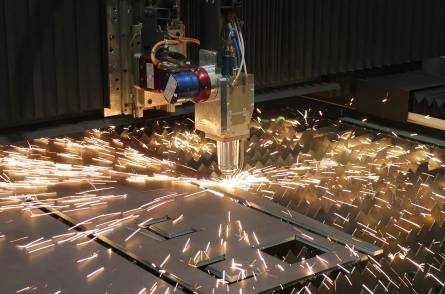How metal fabricators can eliminate postprocessing operations while improving weld prep
Fabricators commonly employ bevel cuts on sheet metal to prepare the material edge for welding. By creating beveled edges, the weld surface area is increased, enabling better material penetration, particularly for thick parts. This results in stronger welds that exhibit enhanced resistance to stress.
Achieving a precise and uniform bevel cut with the correct inclination angles is crucial in creating a weldment that meets the necessary code and tolerance specifications. If the bevel cut lacks uniformity across its entire length, automated welding processes may struggle to achieve the desired quality standards. In such cases, manual welding techniques might be necessary to ensure optimal control over the flow of the filler metal.
Beveling With a Laser
Metal fabricators constantly strive to reduce costs, and one effective way to achieve this is by integrating cutting and beveling operations into a single step. By combining these processes, efficiency is improved, and the need for additional steps like drilling and edge cleaning can be eliminated, resulting in cost savings.
Laser cutting machines equipped with advanced 3D heads and five interpolated axes offer a versatile solution for metal fabrication. These machines can perform multiple processes such as hole drilling, beveling, and marking in a single cycle, eliminating the need for additional postprocessing operations. With precise interior bevel cutting capabilities and the ability to drill high-tolerance, straight, and tapered small-diameter holes, these lasers streamline the production process and ensure accuracy throughout the entire length of the cut.
X Beveling With a Laser
With the advanced 3D bevel head, it is possible to achieve precise and versatile bevel cuts. The head can rotate and tilt up to 45 degrees, enabling the cutting of various bevel shapes, including internal contours, variable bevels, and multiple bevel contours like Y, X, or K. It is capable of direct beveling on materials ranging from 1.37 to 1.57 inches thick, depending on the application and bevel angles. The bevel head offers a wide cut angle range of -45 to +45 degrees, providing flexibility for different beveling requirements.
The X bevel is a crucial bevel shape utilized in various industries such as shipbuilding, railway component manufacturing, and defense applications. It is particularly important when the welding process can only be performed from one side of the piece. Typically, the X bevel has angles ranging from 20 to 45 degrees and is commonly used for welding sheets up to 1.47 inches thick. This type of bevel enables effective and reliable welds, ensuring structural integrity and strength in the welded components.
During tests conducted on 0.5-inch-thick grade S275 steel plate using SG70 welding wire, laser cutting was employed to create a precise top bevel. The bevel had a 30-degree angle and a height of 0.5 inches in the straight cut. A comparison with other cutting methods revealed that laser cutting resulted in a smaller heat-affected zone. This reduction in heat-affected zone contributed to an enhanced welding outcome, leading to improved overall welding quality.
To achieve a 45-degree bevel, the maximum sheet thickness should not exceed 1.1 inches in order to obtain a total bevel surface length of 1.6 inches.
Cut Quality
The process of straight and bevel cutting creates distinct vertical lines. The quality of the finish is determined by the surface roughness of the cut.
The roughness of the edge not only impacts its appearance but also its friction properties. In general, minimizing roughness is preferred as clearer lines contribute to a higher-quality cut.
To achieve the desired results in laser beveling, it is essential to have a comprehensive understanding of the material’s behavior and the precise interpolated movements required for interior bevel cutting.
Making Adjustments

The process of optimizing fiber laser settings for high-quality beveling is similar to the adjustments needed for straight cuts. However, the key difference lies in utilizing robust software capable of supporting various technologies and cutting tables to achieve optimal quality in bevel cutting.
To facilitate bevel cutting operations, it is essential for the operator to have the ability to customize the machine settings for specific tables designed for both exterior and perimeter cuts. However, even more crucial is the capability to adjust the machine settings for tables that enable precise interior cuts through interpolated motion.
All-in-One Process
The 3D head equipped with five interpolated axes is equipped with a gas supply system that enables the use of oxygen and nitrogen, a capacitive height measurement system, and an arm tilt capability of up to 45 degrees. These advanced features greatly enhance the machine’s beveling capabilities, particularly when working with thick metal sheets.
This cutting-edge technology provides comprehensive part preparation in a single streamlined process, eliminating the manual requirement for edge preparation in welding. It empowers the operator to have full control over all the processes involved in achieving the desired final product.

